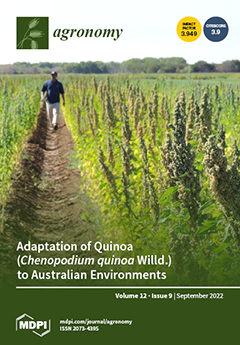The benefits of washed rice water (WRW) as a plant fertilizer, particularly over a consecutive application period, are not well studied. An experiment was therefore carried out to determine: the continuous effects of applying unfermented (F0) and 3-day fermented (F3) WRW on the: (1) soil chemical properties, soil bacterial count, and the growth and plant nutrient content of a test crop, choy sum (
Brassica chinensis var. parachinensis), grown on three contrasting soil textures (sandy clay loam, clay, and silt loam); (2) nutrient leaching losses from these three soils due to the continuous application of WRW; (3) crops’ improvement in water use, if any, in terms of its water productivity (WP) and water use efficiency (WUE); and (4) the relationship between soil bacterial count and plant growth parameters. The effects of F0 and F3 were compared with conventional NPK fertilizer and a control (only tap water; CON). Two factors, treatments and soil types, were used factorially in a randomized complete block design for three consecutive planting cycles. Results showed that NPK and F3 produced a significantly (
p < 0.01) higher plant growth in terms of fresh and dry leaf weights and total leaf area by 5 to 61%, compared to that obtained in the other treatments. Furthermore, plants receiving either NPK or F3 had a significantly higher plant nutrient content (P, K, Ca, Mg, and Cu) in the third planting cycle. Clay soil treated with F3, NPK, and F0 had significantly higher
, P, Ca, Mg, Zn, and B, by 19 to 152% relative to the other soils, irrespective of treatments. Soil nutrient leaching losses of P, K, Ca, Mg, Cu, Zn, and B decreased with successive planting cycles for all treatments. However, soils treated with either F3 or F0 experienced higher leaching of
and
by 37 to 259% and 13 to 34%, respectively, relative to the NPK and CON. Plants treated with either NPK or F3 also had higher WP by 21 to 42% than the other treatments. For all the treatments, plants’ WUE increased with successive planting cycles; however, there was no significant difference between the treatments. F3 stimulated a significantly higher growth and yield of choy sum due to its nutrient and bacterial contents, and the continuous increase in plant growth with successive planting cycles indicated the carryover effects of the treatments, particularly by F3.
Full article





